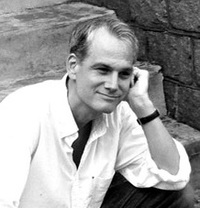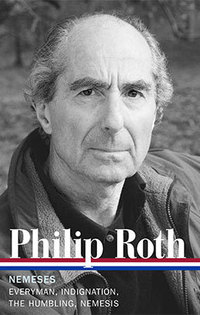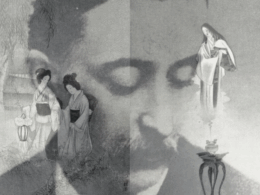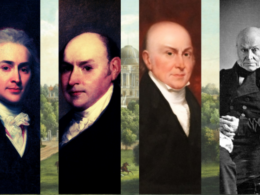Last September Blake Bailey (the prize-winning biographer of Richard Yates and John Cheever) announced that he had agreed to write Philip Roth’s authorized biography, with unfettered access to the writer’s archives and correspondence. To commemorate the publication of the last two volumes of The Library of America’s definitive Philip Roth edition (Novels 2001–2007 and Nemeses), he spoke with us recently about Roth’s later works and how he will—and will not—approach the task of writing the biography.
LOA: Philip Roth’s career has been marked by a remarkable series of reinventions and transformations: the great breakthrough of Portnoy’s Complaint in the late 60s, the Zuckerman trilogy/epilogue in the late 70s and 80s, the masterpiece Sabbath’s Theater, the American Trilogy in the late 90s. Amazingly, at the age of sixty-eight, he then goes on in the next ten years to write the seven books published in these two Library of America volumes. What do you make of this accomplishment, and what in American or world letters would you compare with it?

Bailey: In terms of versatility and breadth of achievement, I don’t think there is much to compare it with. Saul Bellow evolved in interesting ways over the course of his career, but once he hit his stride with The Adventures of Augie March, the style of his mature work was consistently, recognizably Bellovian. Cheever’s work changed remarkably—largely for the better—over the course of his long career: reading The Stories of John Cheever, Bellow remarked that he could “see the transformation taking place on the printed page.”
Then there’s Roth. Six years ago, The New York Times Book Review canvassed some two hundred “writers, critics, editors, and other literary sages,” asking them to identify the “single best work of American fiction published in the last twenty-five years.” Six of the twenty-two books selected for the final list were written by Roth: Operation Shylock, The Counterlife, Sabbath’s Theater, American Pastoral, The Human Stain, and The Plot Against America. But of course Roth’s career extends—in both directions—well beyond the twenty-five years prescribed by the Times survey, and includes arguably his two most famous (if not his best) books, Goodbye, Columbus (1959) and Portnoy’s Complaint (1969). That first book is a delightful satire about Jewish suburban life at mid-century, but one could hardly predict, reading it, that its author would go on to write such incisive and essentially tragic novels as American Pastoral, The Human Stain, and Everyman.

LOA: The Library of America volume Nemeses gathers the four short novels Everyman, Indignation, The Humbling, and Nemesis together for the first time as a single work, as Roth conceived them. How do you see this work in relation to what comes before, for example to the Zuckerman quartet and American Trilogy?
Bailey: Mostly as a tightening of the lens on Roth’s part. The first and last books of the Zuckerman quartet, The Ghost Writer and The Prague Orgy, are shorter than most of the novels in the Nemeses group, but are very much components of a larger work—a work that was always conceived with the ending in mind: namely, Zuckerman’s discovery of the plight of dissident writers in Czechoslovakia, where literature is all the more potent because it’s repressed by the state, which of course forces Zuckerman to reconsider his own travails in terms of a global perspective. The American Trilogy features non-literary protagonists who all, in different ways, run afoul of the insidious forces of postwar American life, from McCarthyism to its ironical, latter-day equivalent, political correctness, and of course the canvas of each novel is vast. The Nemeses books focus on how a particular character responds to certain aspects of his mortality; time and place are important, of course—especially in the cases of Indignation and Nemesis—but mostly serve as a framework for the hero’s solitary predicament. Oh, and some say the Nemeses books lack the usual Rothian humor, but I’m not sure I agree. The humor’s there, all right, but more quietly so.
LOA: What do you make of Roth’s surprising venture, in The Plot Against America, into “alternative history,” a genre that isn’t often the domain of literary novelists. What do you think attracted him to this genre?
Bailey: Roth remembers his childhood in the Weequahic section of Newark as mostly idyllic. The neighborhood was almost entirely Jewish, all his friends lived nearby and would gather at his house, which his kindly, competent parents made a very gemütlich place to visit. Also, Weequahic High School was one of the best in the state: full of high-achieving, second-generation Jewish kids who were eager to make their doting parents proud of them. Later, as Roth became more aware of rabid anti-Semitism (not to say the insecurity it provoked in Jews of his parents’ generation), I think he appreciated all the more just how fortunate a childhood he’d had, and how tenuous it was in many ways. Charles Lindbergh was an anti-Semite who openly chided the Jews for getting America into the war; he was a national hero who was especially admired by his fellow isolationists on the right. The pervasive anti-Semitism of war-time America was a potential tinderbox that certain demagogues such as the despicable Father Coughlin, say, might have liked to ignite. So what if the match had been struck by a Lindbergh presidency? It’s an irresistible question, and we should be grateful our greatest living novelist saw fit to address it.
LOA: Do you have a personal favorite among these late works?
Bailey: I’m very partial to Everyman. A masterpiece, I think.
LOA: What do you think about Philip Roth’s announcement of his retirement?
Bailey: I’m happy because I think he’s happy. As recently as five years ago, retirement would have been out of the question because he still had another two or three books he wanted to write. Now he’s finished, and he has a mountain of richly deserved laurels to rest on. He’s earned the chance to be dans le vrai, as his beloved Flaubert would have it.
LOA: As a biographer, how do you compete with a writer who has so thoroughly and brilliantly transmuted his life into his work? And how do you feel about the rather unflattering portrayal of biographer Richard Kliman in Exit Ghost? There’s a sense in that book that biographers can overstep their bounds, and that to do so is a kind of ethical offense, an outrage even. Does this make you nervous?
Bailey: No, it doesn’t make me nervous at all. Whatever my other faults, I’m not the kind of biographer that Kliman is. Kliman takes hold of a rumor that he thinks will explain everything, the life and the work, and it’s a nasty little rumor—that E. I. Lonoff, Zuckerman’s revered mentor, had an incestuous relationship with his half-sister. Whether this is true or not is beside the point: no human life—much less that of a great artist—can be explained with a single theory, a nasty little rumor, that becomes for people like Kliman a strand to which everything else is attached, and what can’t be attached is swept under the rug. The result is a lot of tendentious psychobabble, and Roth despises psychobabble and pat conclusions very much in general. What I try to do as a biographer is learn everything, or anyway as much as possible, and then determine what the main themes (plural) are, and how they relate (if at all) to the work and vice versa. The themes are multifarious, the contradictions are vast, and to what extent can they be resolved? That’s the good biographer’s task. As for “competing” with Roth, I’m doing nothing of the sort. It’s apples and oranges. As you say, he “transmuted” his life into the work, and if anything I’m doing the opposite.
LOA: Roth will celebrate his eightieth birthday this month in Newark, the city that may be the essential touchstone of his career. What does Newark tell us about Roth, and what does Philip Roth’s Newark tell us about America?
Bailey: Plenty, as I hope more and more readers will discover in the centuries ahead. For now, let us all pause a moment on March 19 and raise a glass to Philip Roth on the occasion of his eightieth birthday. He has gotten his work done, and the world is a better place for it.



